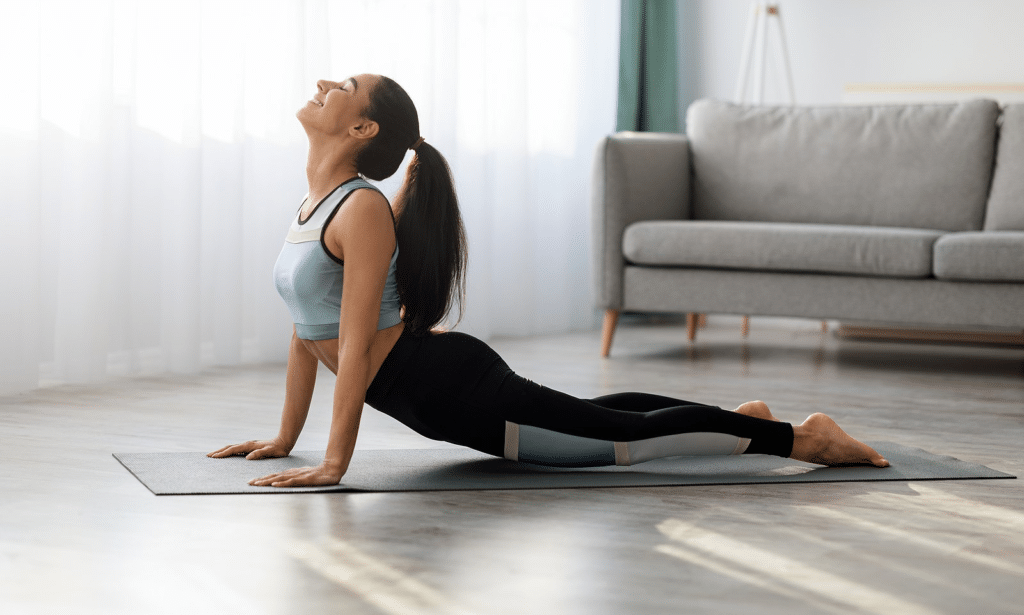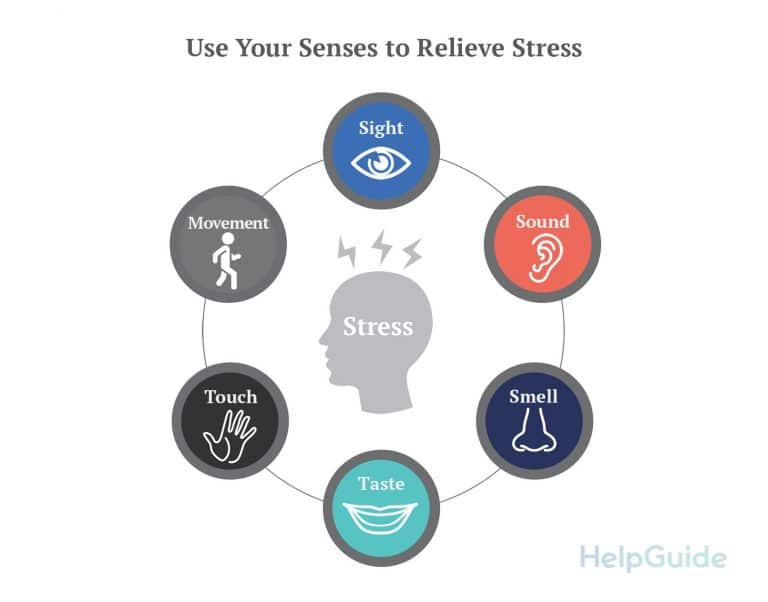In this Quick Stress Relief Guide, you will learn how to use the power of your senses to relieve stress and stay calm and focused right away, no matter what life throws at you.

©elite24er.com
What is the fastest way to relieve stress?
Firstly, there are numerous methods for managing stress. For instance, Yoga, mindfulness meditation, and exercise are just a few stress-relieving exercises that work wonders. But in the heat of the moment (during a job interview, for example, or a conflict with your partner), you can’t just excuse yourself to meditate or take a long walk. Therefore, in these situations, you need something more suitable.
One of the fastest and most reliable ways to relieve stress is to engage your senses—sight, sound, taste, smell, touch—or through movement. Since everyone is different, you must test which technique works best for you. Ultimately, the gain is immense because you can stay calm, productive, and focused if you quickly reduce stress.
Social interaction is the most advanced and reliable way for your body to regulate the nervous system. Having a conversation in person with someone who is relaxed and caring can help you calm down and release tension quickly. Even though you may not always have someone to rely on during stressful situations, it’s vital to maintain close relationships for your mental well-being.
First Tip: Can you recognize when you’re being stressed?
It might appear evident that you know when you’re stressed, but many of us spend so much time noting that we’ve forgotten what it feels like to be calm and balanced. Most importantly, you can recognize your stress by listening to your body. For example, when you’re tired, your eyes feel heavy, and you might rest your head on your hand. However, when you’re joyful, you laugh easily. And when you’re stressed, your body lets you know that, too. That’s why it is imperative to get in the habit of paying attention to your body’s hints. So, how can you do that?
Observe your muscles and insides.
Are your muscles tense or sore? Is your stomach tight, cramped, or aching? Are your hands or jaw clenched?
Observe your breath.
Is your breathing shallow? Place one hand on your belly and the other on your chest. Watch your hands rise and fall with each breath. Notice when you breathe fully or when you “forget” to breathe.
Second Tip: Do you recognize your stress response?
When we experience stress, our bodies respond similarly by activating the “fight-or-flight” stress reaction. This results in increased blood pressure, heart rate, and muscle tension. You have to be aware that the body works hard during this process, which can weaken the immune system, especially if you are under stress for longer. However, people can exhibit different external responses to stress. That’s why it’s essential to identify your specific stress response to relieve stress effectively. Down below, you will find two of the most common stress responses.
- Overexcited stress reaction: If you get angry, agitated, or overly emotional, you will respond best to stress relief activities that quiet you down.
- Underexcited stress reaction: If you tend to become depressed, withdrawn, or spaced out under stress, you will respond best to stress relief activities that are stimulating and energizing.
The frozen stress response
Do you find yourself freezing when you are under stress? Although freezing might seem like an appropriate response to a threat, in humans, it can manifest as an inability to communicate, react, or take any action to protect oneself.
But can we control our stress response? Yes, we can. Once we become aware of the events that trigger these reactions, we can use grounding techniques to help us. Some helpful techniques include deep breathing, paying attention to our surroundings, and using verbal self-affirmations such as “You are safe.” Physical movement (such as walking, swimming, running, or dancing) can also be beneficial. As we move, we should focus on our body and the sensations we feel in our limbs instead of our thoughts.
The best way to avoid a negative response is to heal the underlying trauma from the past that causes it. By doing so, we can remove or reduce the trigger and respond more calmly and safely to perceived threats.
Third Tip: How do you bring your senses to the rescue?
To quickly relieve stress using your senses, it’s essential to identify which sensory experiences work best for you. All this may require some exploration. As you engage with different senses, note how quickly your stress levels decrease and be as specific as possible. For example, if you love music, listen to various artists and genres until you find the one that instantly lifts and relaxes you.
It’s also helpful to research and discover various sensory experiences to have multiple tools to relieve stress no matter where you are. The examples provided are just a starting point, so let your imagination run wild and develop additional ideas to try. Once you find the sensory technique that works for you, you’ll know it!

©helpguide.org
Sight
- Look at a photo of your beloved person, friend, or favorite souvenir.
- Use a plant or flowers to revitalize your workspace.
- Appreciate the beauty of nature: a garden, the beach, a park, or your backyard.
- Close your eyes and picture a place that feels peaceful and refreshing.
Smell
- Light a scented candle or burn some fragrance.
- Try out various essential oils.
- Smell the roses or another type of flower.
- Experience the pleasure of breathing in clean, refreshing air while exploring the outdoors.
- Apply your favorite perfume or cologne by spraying a few spritzes.
Touch
- Wrap yourself in a warm blanket.
- Pet a dog or cat.
- Hold a pleasant object (a stuffed animal, a favorite memento).
- Give yourself a hand or neck massage.
- Wear clothes that feel soft against your skin.
Taste
Slowly savoring a favorite treat can be very relaxing, but mindless eating will only add to your stress and your waistline. The key is to satisfy your sense of taste mindfully and in moderation.
- Chew a piece of sugarless gum.
- Indulge in a small piece of dark chocolate.
- Sip a steaming cup of coffee or tea or a refreshing cold drink.
- Eat a perfectly mature piece of fruit.
- Enjoy a healthy, crunchy snack (celery, carrots).
Motion
If you tend to shut down when you’re experiencing stress or have gone through trauma, engaging in physical activities that help you relieve stress could be particularly beneficial. Run in place or jump up and down.
- Dance around.
- Stretch or roll your head in circles.
- Go for a short walk.
- Squeeze a rubbery stress ball.
Sound
- Sing or play a favorite tune.
- Listen to relaxing or uplifting music.
- Tune in to nature’s soundtrack—crashing waves, the wind rustling the trees, birds singing.
- Buy a small fountain in your home or office to enjoy the soothing sound of running water.
Vocal toning
Vocal toning is a practice that can help reduce stress hormone levels like adrenaline and cortisol. If you’re feeling anxious or stressed before the first date, try finding a calm place to do toning exercises. This technique works by engaging the small muscles in your inner ear responsible for detecting the higher frequencies of human speech, which convey emotion and meaning. By toning, you can exercise and strengthen these muscles, which will help you better understand what your boss is trying to communicate and feel more relaxed during the meeting.
How to tone
Sit up straight and make “mmmm” sounds with your lips together and teeth slightly apart. Make an experiment by changing the pitch and volume until you experience a pleasant vibration in your face and, eventually, your heart and stomach.
Fourth Tip: Discover sensory inspiration
Need help to identify sensory techniques that work for you? Look for inspiration around you, from your sights as you go about your day to memories from your past.
Memories.
Think back to what you did as a child to calm down. You might benefit from tactile stimulation if you had a blanket or stuffed toy. Try tying a textured scarf around your neck before an appointment or keeping a piece of soft suede in your pocket.
Watch others.
Observing how others deal with stress can give you valuable insight. Baseball players often pop gum before going up to bat. Singers often chat up the crowd before performing. Ask people if you know how they are focused under pressure.
Parents.
Think back to what your parents did to blow off steam. Did your mother feel more relaxed after a long walk? Did your father work in the yard after a hard day?
The power of imagination.
Once drawing upon your sensory toolbox becomes a habit, imagine vivid sensations when stress strikes. The memory of your baby’s face will have the same calming or energizing effects on your brain as seeing her photo. When you can recall an intense sensation, you’ll never be without a quick stress relief tool.
Take a break from technology.
Taking a short hiatus from the television, computer, and cell phone will give you insight into how your senses respond best.
- Try tuning into relaxing music instead of talk radio during your commute. Or try r ding in silence for 10 minutes.
- Are you stuck in a long line at the grocery store? Instead of talking on your phone, take a moment to people-watch. Pay attention to what you hear and see.
- Instead of checking email while waiting for a meeting, grab a few deep breaths, look out the window, or sip some tea.
- While waiting for an appointment, resist the urge to text and give yourself a hand massage instead.
Fifth Tip: Make quick stress relief a habit.
Remembering to use your senses in a minor or significant crisis can be challenging. Initially, it may seem more straightforward to give in to the pressure and tense up. However, tuning in to your senses will become more natural with practice. It’s similar to learning how to drive or play golf- you don’t become an expert in one lesson; you must practice until it becomes second nature. Eventually, you’ll need to pay attention to your body during stressful moments. Here’s how you can make it a habit:
Start small.
Instead of testing your quick stress relief tools on a source of significant stress, start with a predictable low-level source of stress, like cooking dinner at the end of a long day or sitting down to pay bills.
Identify and target.
Think of just one low-level stressor you know will occur several times a week, such as commuting. Vow to target that stressor with quick stress relief every time. After a few weeks, target a second stressor, and so on.
Test-drive sensory input.
If you are practicing quick stress relief on your commute to work, bring a scented handkerchief with you one day, try music another day, and a movement the next day. Keep experimenting until you find a clear winner.
Have fun with the process.
If something doesn’t work, don’t force it. Move on until you find what works best for you. It should be pleasurable and noticeably calming.
Talk about it.
Telling friends or family members about the stress-relief strategies you’re trying out will help you integrate them into your life. As a bonus, it’s bound to start an exciting conversation: everyone relates to stress.
Sixth Tip: Practice wherever you are
The best part of sensory-used strategies is the awareness that you have control. Quick stress relief is within arm’s reach no matter where or what you’re doing.
Quick stress relief at home
Have fun.
Prevent pre-party jitters by playing lively music—and lighting candles. The flicker and scent will stimulate your senses. Wear clothes that make you feel relaxed and confident.
Kitchen.
Ease kitchen stress by breathing in every ingredient’s scent—delight in an eggshell’s delicate texture. Appreciate the weight of an onion.
Children and relationships.
Prevent losing your cool during a spousal spat by squeezing the tips of your thumb and forefinger together. Rub lotion into your hands when your toddler has tantrums and breathes in the scent.
Sleep.
Too stressed to sleep? Try using a white noise machine for background sound or a humidifier with a diffuser for a light scent in the air.
Create a sanctuary.
If clutter bothers you, take 10 minutes daily to tidy up. Decorate with photos and images that bring you joy, and open the curtains to let in natural light.
Quick s stress relief at work
My things.
During stressful sessions, stay connected to your breath. Massage the tips of your fingers. Wiggle your toes. Sip coffee.
On the phone.
Inhale something energizing, like lemon, ginger, and pepper int. While talking, stand up or pace back and forth to burn off excess energy or take calls outside when possible.
On the computer.
Work standing up. Do knee-bends in 10-minute intervals. Suck on a peppermint. Sip tea.
Lunch breaks:
- Take a walk around the block or in the parking lot.
- Listen to soothing music while eating.
- Chat with a colleague.
Your workspace.
Place family photos on your desk or mementos that remind you of your life outside the office.
Quick stress relief on the road
In traffic.
Play music or listen to an audiobook. Take a different route to see something new. Do neck-rolls at stoplights. Sing in the car to stay awake and happy.
Public transportation.
Take a break from reading, cell conversations, and music to tune into the sights and sounds around you. Try noticing something new, even on the same old bus ride.
Running errands.
Wear a unique p perfume or lotion to enjoy it while you rush from place to place. Carry a stress ball in your pocket. Take a mental “snapshot” or “postcard” at each destination.
Waiting in lines.
Instead of worrying about time slipping away, focus on your best thing. People watch. Chat with the person ahead of you. Chew a stick of minty gum.
That was all from us for now. But if you have some Quick stress relief techniques that work for you, please share them with us in the comments below.
References and sources:
Photo credits:
Feature photo credits: elite24er.com



